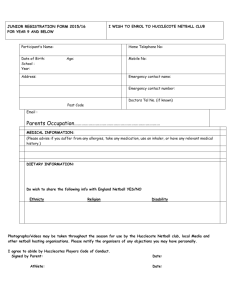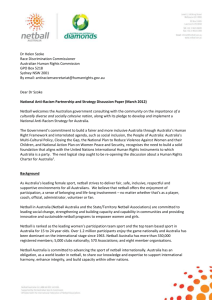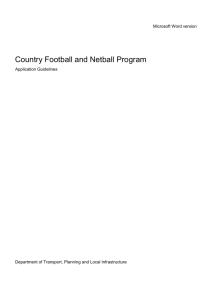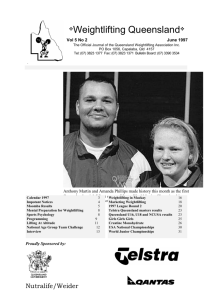Strategic Planning Information Sheet
advertisement
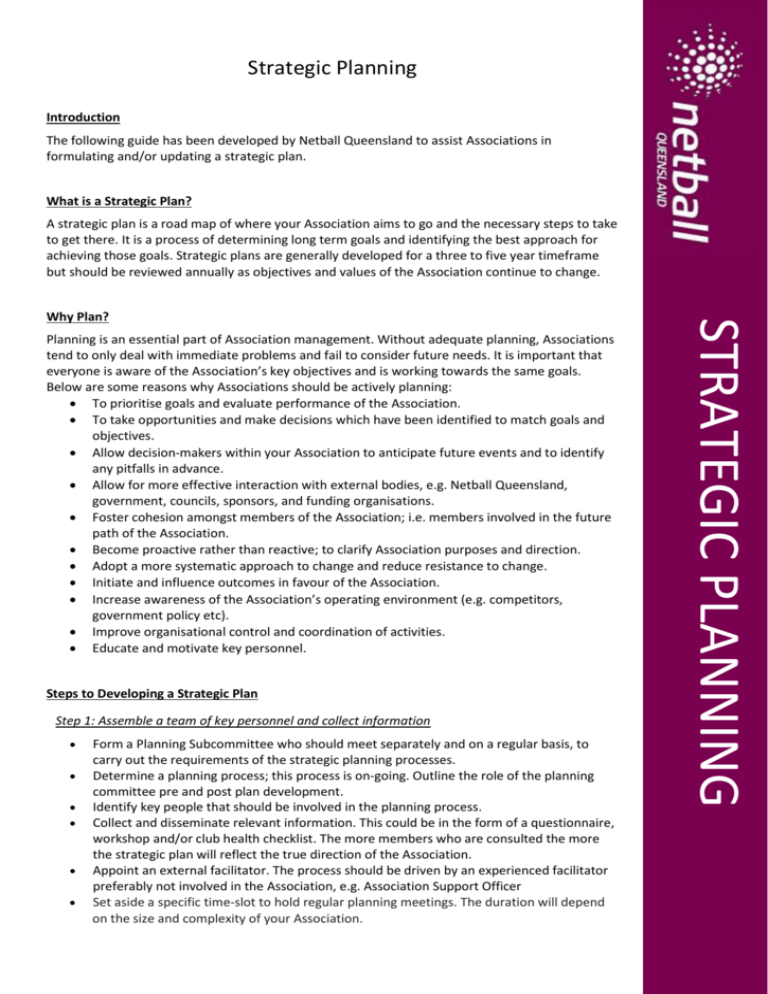
Strategic Planning Introduction The following guide has been developed by Netball Queensland to assist Associations in formulating and/or updating a strategic plan. What is a Strategic Plan? A strategic plan is a road map of where your Association aims to go and the necessary steps to take to get there. It is a process of determining long term goals and identifying the best approach for achieving those goals. Strategic plans are generally developed for a three to five year timeframe but should be reviewed annually as objectives and values of the Association continue to change. Planning is an essential part of Association management. Without adequate planning, Associations tend to only deal with immediate problems and fail to consider future needs. It is important that everyone is aware of the Association’s key objectives and is working towards the same goals. Below are some reasons why Associations should be actively planning: To prioritise goals and evaluate performance of the Association. To take opportunities and make decisions which have been identified to match goals and objectives. Allow decision-makers within your Association to anticipate future events and to identify any pitfalls in advance. Allow for more effective interaction with external bodies, e.g. Netball Queensland, government, councils, sponsors, and funding organisations. Foster cohesion amongst members of the Association; i.e. members involved in the future path of the Association. Become proactive rather than reactive; to clarify Association purposes and direction. Adopt a more systematic approach to change and reduce resistance to change. Initiate and influence outcomes in favour of the Association. Increase awareness of the Association’s operating environment (e.g. competitors, government policy etc). Improve organisational control and coordination of activities. Educate and motivate key personnel. Steps to Developing a Strategic Plan Step 1: Assemble a team of key personnel and collect information Form a Planning Subcommittee who should meet separately and on a regular basis, to carry out the requirements of the strategic planning processes. Determine a planning process; this process is on-going. Outline the role of the planning committee pre and post plan development. Identify key people that should be involved in the planning process. Collect and disseminate relevant information. This could be in the form of a questionnaire, workshop and/or club health checklist. The more members who are consulted the more the strategic plan will reflect the true direction of the Association. Appoint an external facilitator. The process should be driven by an experienced facilitator preferably not involved in the Association, e.g. Association Support Officer Set aside a specific time-slot to hold regular planning meetings. The duration will depend on the size and complexity of your Association. STRATEGIC PLANNING Why Plan? Step 2: Analysis Review previous strategies or outcomes. What has not worked? How can things be done differently? Undertake an analysis of trends within the sport and recreation industry (other sporting organisations/netball groups/netball Associations). How could these trends affect your association in future? Analysis of your member’s needs. What were the results of the questionnaires/workshop/checklist? Use the results from the member analysis to identify all Strengths, Weaknesses, Opportunities and Threats (SWOT analysis) that influence the Association. Undertake a unified planning approach – develop Association Values, Vision and Mission Statement (review if these already exist). Use the information from the SWOT analysis to develop SMART goals (Specific, Measurable, Achievable, Realistic and Timely). Try to arrange them in categories, e.g. management, operational, marketing, and financial. Draft an action plan (see appendix for a template). Put together all the information collected in steps 1 & 2 into a document. Below is an example of a Strategic Plan layout. You should add and/or delete sections to fit the needs, size and structure of your Association. Strategic Plan Layout: 1) A cover sheet should include: name of the Association and logo (if applicable) Association address contact information – telephone, facsimile and e-mail date it was approved and review date 2) Table of contents: This needs to be accurate to reflect the details of the document to the reader. 3) Association history: history of milestones, past successes in meeting objectives of the Association 4) The vision of the Association: Refers to the values and the mission statement. 5) SWOT analysis: Strengths, Weaknesses, Opportunities and Threats 6) A list of identified goals over the long term which address the key issues outlined in the SWOT analysis. Goals can be best described as the ‘destination points’ being aimed for. They act as the reference guide for the decision making. They give you a clear picture of where your Association wishes to be in the long term. Format goals in key areas, e.g. Management, marketing, operational, financial, etc. 7) Action Plan: Tables identifying key performance areas, goals, actions, timeline etc. Formatting the information in tables makes it easy to read and understand. See appendix 1 for a basic action plan template. 8) Evaluation: Explain how your association will monitor progress and performance. The strategic plan will need to be reviewed yearly. Who will be responsible for ensuring the strategic plan is adhered to and updated accordingly? Step 4: Implement Your Strategic Plan Give your members the opportunity to comment on a draft strategic plan. Ask if it clearly represents the Association’s goals and directions and make adjustments where necessary. Ensure key stakeholders agree and adopt the strategic plan at a Management or General Meeting. Communicate and promote the Association’s new strategic plan. Enable members to voice their opinions and vote on any changes to the document at a General Meeting. STRATEGIC PLANNING Step 3: Develop Your Strategic Plan References: Aus sport commission – The Planning Process Aus Sport Commission – Characteristics of Strategic Planning Aus Sport Commission – Planning in Sport Aus Sport Commission – Club planning Our community – strategic and operational planning STRATEGIC PLANNING Appendix 1 – Action Plan Template <Add Key Area> Action Plan Goals Actions (The end result that your Association would like to achieve) (Actions that need to be taken to achieve those goals) Key Performance Indicators (KPIs) (Establish key performance indicators that will measure your ability to achieve the goals) Timeline Responsibility Budget (Create timelines of when each goal should be completed) (Assign someone to be (Asses if any cost is required to carry out an action and include budgets for those intended costs) Completed by November 2013 and adopted at the General Meeting in December 2013 Planning Subcommittee responsible of ensuring each action is completed in a timely manner) Example: To have an active constitution in line with the Incorporations Act Update the current constitution to reflect the changes to the Incorporations Act New constitution adopted by members of the association President $20


